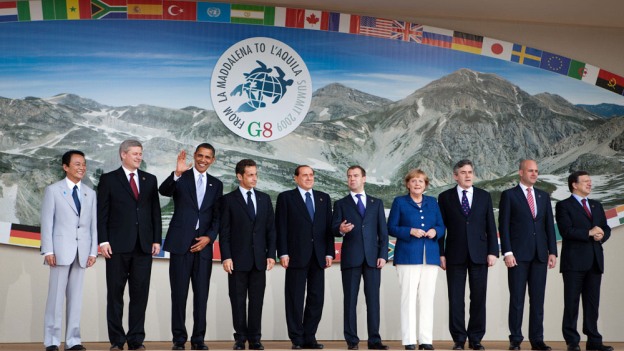If you haven’t been in Italy you might not have realized it, but two events just occurred there in which leaders of the 17 largest-emitting countries tried to make progress in the run-up to the Copenhagen climate talks this December.
The first event was the annual Group of Eight (G8) meeting, which brings together the eight largest industrialized countries and now regularly has global warming on the agenda (as I discussed last year). The second was the “Leaders Summit” of the Major Economies Forum (which I also covered), which brings together the world’s 17 largest emitting countries. The G8 declaration (PDF) was released on July 8th, while the Major Economies Forum statement (PDF) was released July 9th.
These meetings are notorious for taking small steps and are often criticized for being “big on grand statements and small on detailed actions.” But how often do you get the leaders of the world’s biggest countries in one place making joint political declarations? And given the critical need for heads of government to weigh in if we are going to have any chance of success in Copenhagen (as I discussed here), these events come at an important juncture.
Over the past week there have been a lot of moving parts, so I thought I would try to help pull it all together and frame the context. So here goes.
Global “Yardstick” to Solving Global Warming. A number of countries have set forth an objective to hold global temperatures to less than 2 degrees Celsius (3.6 degrees Fahrenheit). In the past, the U.S., Japan, Russia, and Canada had all notably refused to set forth that “yardstick” as the aim of the world’s efforts to solve global warming. It took a little nudging — including a letter from the CEOs of 47 major U.S. organizations to President Obama — but this “yardstick” is now a committment in the G8 agreement, and is included in the Major Economies Forum statement. So effectively you have the world leaders (or at least the major emitters) committing to keep global warming to a level below which scientists tell us a number of very damaging impacts will occur.
So now all the world’s actions will be judged against that yardstick, and we’ll be able to ask: “how does this or that measure up?”
Global Emissions Objective in the Medium-Term. If you read any of the stories prior to the meetings, there was a lot of back and forth on the issue of whether or not there would be a commitment to cut global emissions 50 percent by 2050. Well, here is where it ended up:
- The G8 statement includes a reiteration of their “goal of achieving at least a 50 percent reduction in global emissions by 2050.” They essentially made this statement last year so this isn’t new.
- The Major Economies Forum statement does not include this global objective, but they agreed to develop such a 2050 global goal by Copenhagen. China and India wanted the U.S. (in particular) and other developed countries to commit to deeper near-term targets (in 2020) than they were willing. And they wanted greater clarity on the amount of incentives that the developed countries would propose to support developing countries’ emissions reduction efforts.
In some sense this is where this process was last year (as I discussed here), but of course the world hoped for more this year with the change in U.S. administration. We’ll need to be much further along in that debate on this issue by Copenhagen. But more important than this “global effort” in the medium term is the contribution that individual countries undertake toward this global effort and their path to that target (as I’ll discuss below).
Developed Country Targets. The G8 countries agreed to cut emissions 80 percent by 2050. They fudged the year against which to compare that target (1990 or a more current year), which is very important in terms of how much emissions are put into the atmosphere. But this is still a modestly big step for these countries, as they are now committing to a significant trajectory to reduce their emissions. While this is where President Obama has been as a part of his campaign and since he has taken office, this is the first time that he committed to this in a meaningful way internationally. And for Canada and Russia this is a stronger signal than they’ve provided to date (although there has been some “misunderstanding” on the Russian side about what they actually committed to, as this AFP story outlines).
So now you have the world’s wealthiest countries committing to dramatically shift to clean energy. Some are likely to argue that this will have a huge cost, but all credible analysis (including NRDC’s, available here, and even that of the climate opposition’s, available here) shows that the cost is very reasonable for this transition — less than a postage stamp per day in the U.S. And oh, by the way, we create a bunch of new jobs (as we’ve documented here).
Developing Country Emissions Reductions. In the international debate, the issue of whether and how much developing countries would reduce their emissions has been at the top of the agenda for a while (as I’ve discussed here and here). While the actions and statements from developing countries have greatly changed over the years, the political commitment from developing country leaders at formal summits hasn’t solidified that new position. Well, that has changed slightly this week as the Major Economies Forum agreed that developing countries will commit to “slow the rate of growth of their emissions in the near-term” (as the New York Times is also reporting). The G8 agreement includes even stronger language, but it’s in a sense easier to agree to, as it doesn’t require developing country support.
And, importantly, the Major Economies Forum also agreed that developing countries (actually all countries) would:
- undertake “transparent nationally appropriate mitigation actions, subject to applicable measurement, reporting, and verification” (which has become a central issue to securing a strong agreement in Copenhagen as I discussed here); and
- “prepare low-carbon growth plans” (which is an important aspect of the international negotiations, as I’ve discussed here).
While much more clarity will need to be provided before the U.S. Senate will be completely satisfied, this is a solid building block to get an agreement in Copenhagen and ultimately something that the U.S. can implement domestically.
Working to Develop the Financing Incentives for Developing Countries. Providing “significant, targeted, and effective” incentives to help developing countries reduce their emissions and adapt to the impacts of global warming will be essential to getting a strong agreement in Copenhagen. That is an important but difficult challenge for many developed countries, including the U.S. (as is evidenced by our efforts to convince Congress to deliver this funding in the climate bill and elsewhere as I discussed here).
That is why the Major Economies Forum “asked the G20 finance ministers to take up the climate financing issues and report back to us at the G20 meeting in Pittsburgh in the fall” (as President Obama committed to in his final statement after the Major Economies Forum meeting). So the upcoming G20 meeting will now become a hugely important moment to see whether or not developed countries can deliver the necessary financial incentives to help to break open the current stalemate between developed and developing countries.
—–
It isn’t too surprising that the stories on the global warming events are painting a mixed picture. This kind of event is always a mixed bag — you want more good parts and less bad parts.
And when looking at what was achieved at these two global warming events, I think there are some emerging signs to build upon. By no stretch of the imagination are we there yet, as we still have a lot of work to complete before we’ll be in a position to get a strong agreement in Copenhagen.
Looking at the totality of what was accomplished, I would say global warming won this “coin flip” … just barely, but enough at this stage in the negotiations to warrant a little optimism.
We have less than six months to put the world on the correct path, and the solutions are obvious and available. But the politics to solve global warming are “complicated.” It’s easy to feel as if the challenge can’t be addressed quickly enough (as I discussed here). So I thought it was perfect to end with the words of President Obama after the Major Economies Forum meeting (since I couldn’t say it any better):
“… I think that one of the things we’re going to have to do is fight the temptation towards cynicism, to feel that the problem is so immense that somehow we cannot make significant strides.
But ultimately, we have a choice. We can either shape our future, or we can let events shape it for us. We can fall back on the stale debates and old divisions, or we can decide to move forward and meet this challenge together…We know that the problems we face are made by human beings. That means it’s within our capacity to solve them. The question is whether we will have the will to do so, whether we’ll summon the courage and exercise the leadership to chart a new course. That’s the responsibility of our generation, that must be our legacy for generations to come, and I am looking forward to being a strong partner in this effort.”




